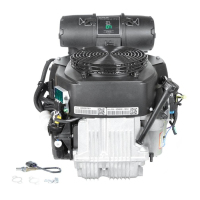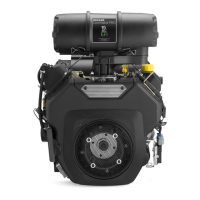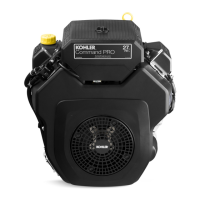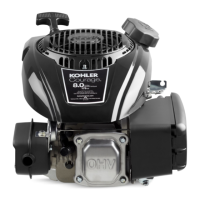3.3
Section 3
Troubleshooting
3
Basic Engine Tests
Crankcase Vacuum Test
A partial vacuum should be present in the
crankcase when the engine is operating. Pressure
in the crankcase (normally caused by a clogged or
improperly assembled breather) can cause oil to be
forced out at oil seals, gaskets, or other available spots.
Crankcase vacuum is best measured with either a
water manometer, or a vacuum gauge (see Section 2).
Complete instructions are provided in the kits.
To test the crankcase vacuum with the manometer:
1. Insert the stopper/hose into the oil fi ll hole. Leave
the other tube of manometer open to atmosphere.
Make sure the shut-off clamp is closed.
2. Start the engine and run at no-load high speed
(3200-3750 RPM).
3. Open the clamp and note the water level in the
tube.
The level in the engine side should be a minimum
of 10.2 cm (4 in.) above the level in the open side.
If the level in the engine side is less than specifi ed
(low/no vacuum), or the level in the engine side
is lower than the level in the open side (pressure),
check for the conditions in the table below.
4. Close the shut-off clamp before stopping the
engine.
To test the crankcase vacuum with the Vacuum/
Pressure Gauge Kit:
1. Remove the dipstick or oil fi ll plug/cap.
2. Install the adapter into the oil fi ll/dipstick tube
opening.
3. Push the barbed fi ing on the gauge solidly into
the hole in the adapter.
4. Start the engine and bring it up to operating
speed (3200-3600 RPM).
5. Check the reading on the gauge. If the reading
is to the le of “0” on the gauge, vacuum or
negative pressure is indicated. If the reading is to
the right of “0” on the gauge, positive pressure is
present.
Crankcase vacuum should be 4-10 (inches of
water). If the reading is below specifi cation, or if
pressure is present, check the following table for
possible causes and remedies.
Possible Cause Solution
1. Disassemble breather, clean parts thoroughly,
reassemble, and recheck pressure.
2. Replace all worn or damaged seals and gaskets.
Make sure all fasteners are tightened securely.
Use appropriate torque values and sequences
when necessary.
3. Recondition piston, rings, cylinder bore, valves,
and valve guides.
4. Repair/replace restricted muffl er/exhaust
system.
1. Crankcase breather clogged or inoperative.
2. Seals and/or gaskets leaking. Loose or
improperly torqued fasteners.
3. Piston blowby or leaky valves (confi rm by
inspecting components).
4. Restricted exhaust.
No Crankcase Vacuum/Pressure in Crankcase

